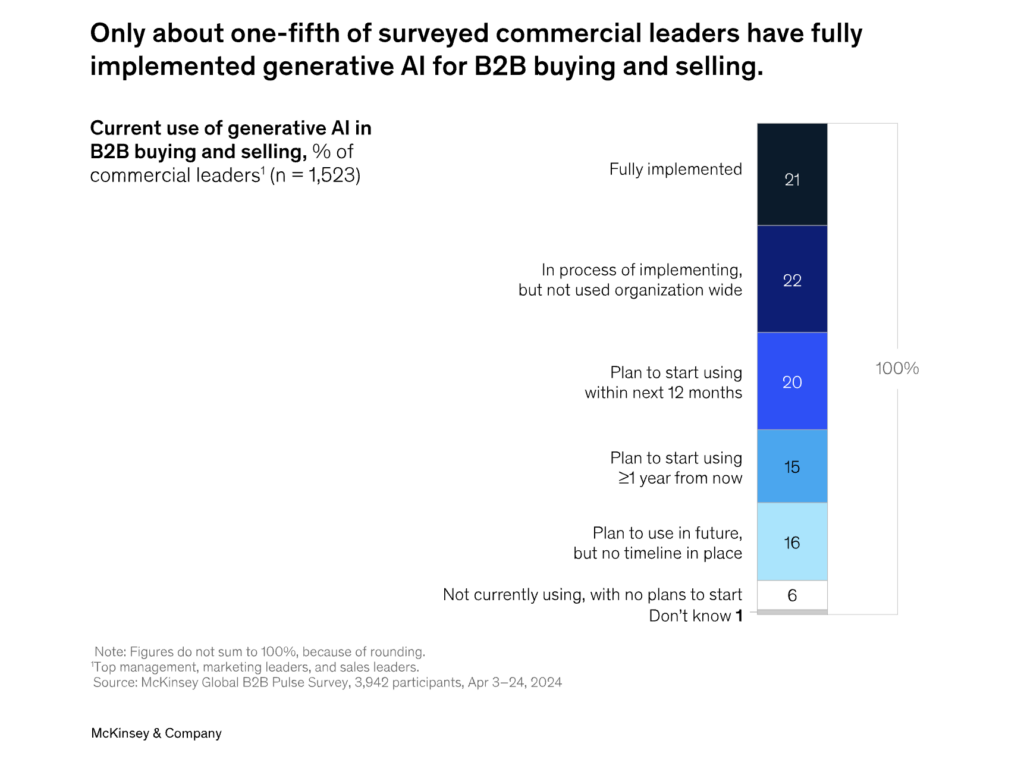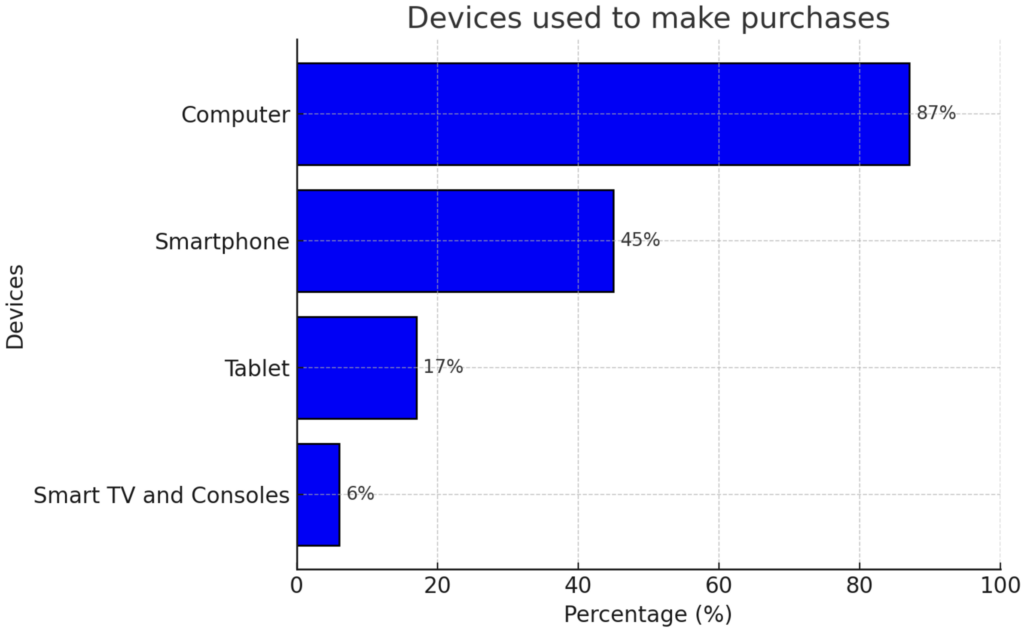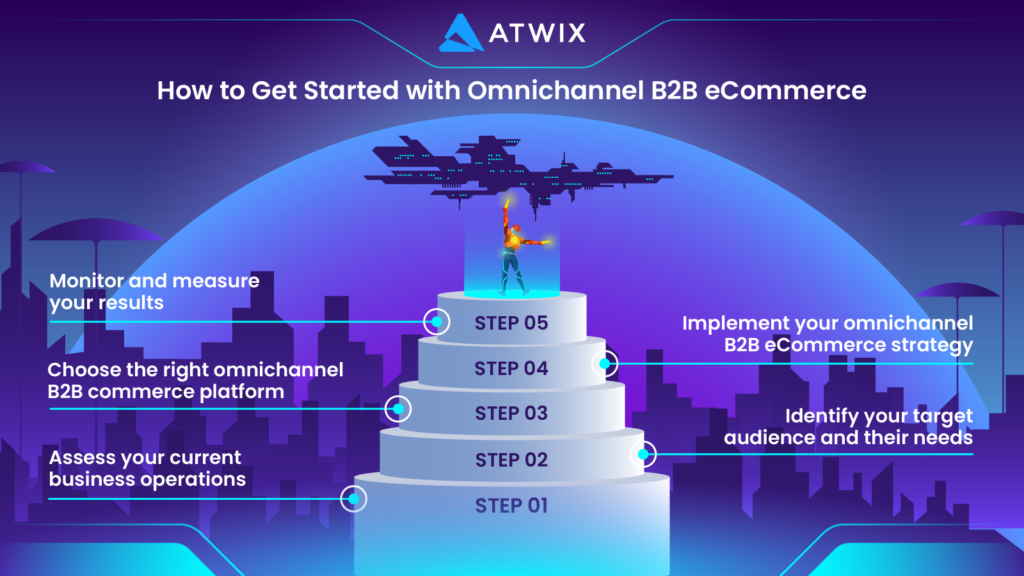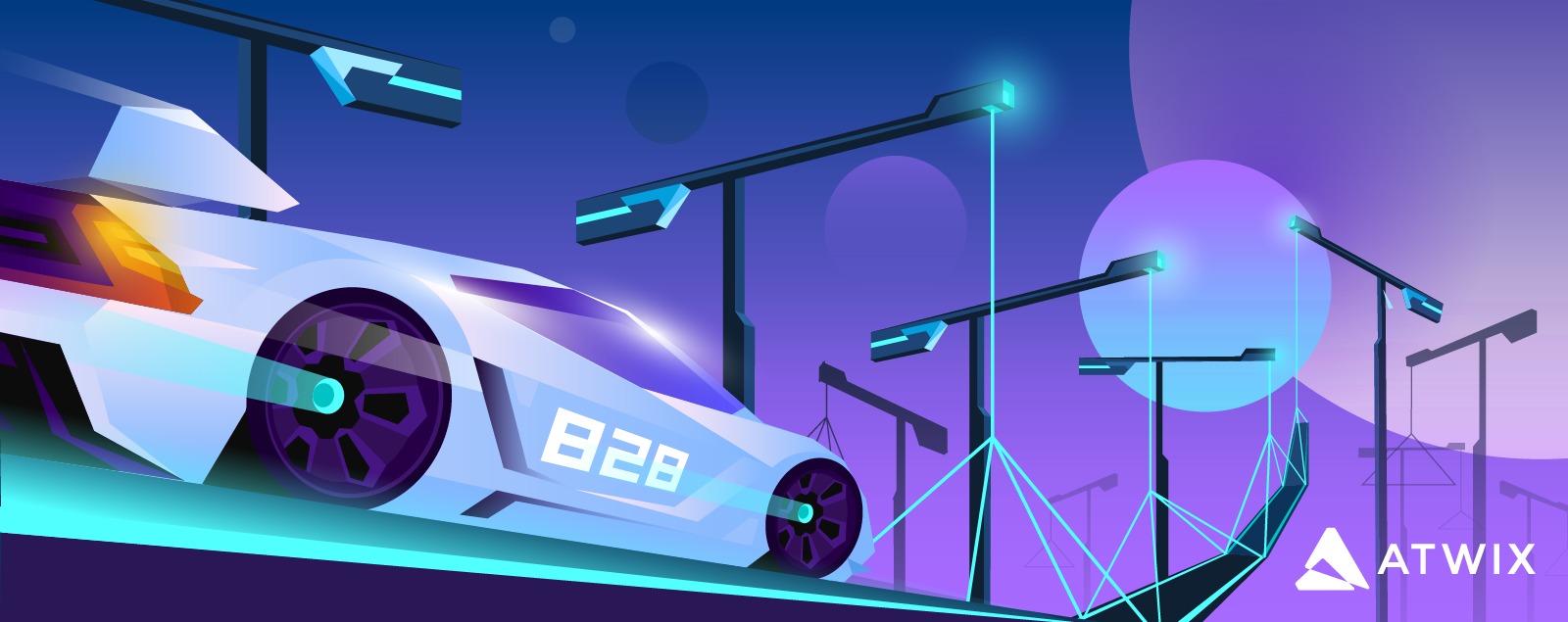Omnichannel B2B eCommerce experiences are essential for meeting customer expectations. B2B buyers now expect a seamless, consistent experience across multiple channels, with research indicating that 74% of B2B buyers prefer online platforms for their purchasing needs. This approach not only enhances customer satisfaction but also boosts market share, as businesses selling via multiple channels see significant growth. Implementing omnichannel strategies also increases brand reach, personalizes customer service, and streamlines operations.
At Atwix, we specialize in delivering high-performance, customer-centric B2B eCommerce solutions to help businesses stay competitive. Here’s an overview of the latest trends, benefits, challenges, and implementation steps for omnichannel B2B eCommerce in 2024/25.
Emerging trends include the rise of AI and machine learning for personalized shopping experiences, the integration of real-time inventory updates, and the increasing importance of sustainability in packaging and deliveries. Additionally, social commerce is gaining traction in B2B eCommerce, offering new opportunities to engage with buyers through social media platforms.
Why B2B Businesses Should Have an Omnichannel Approach
The way B2B buyers engage with businesses has fundamentally changed. Ensuring that your eCommerce platform is mobile responsive is critical for delivering a seamless omnichannel experience, as more B2B buyers now rely on smartphones for product research and transactions. Today, they don’t just want flexibility—they demand it.Omnichannel B2B marketing strategies are designed to engage buyers through integrated campaigns that span multiple channels, from email and social media to in-person interactions. Buyers now interact across an average of ten channels throughout their purchasing journey, a significant jump from just five years ago (McKinsey). For businesses, this means meeting customers wherever they are, ensuring seamless transitions, and delivering consistent experiences. Without a robust omnichannel marketing strategy, businesses risk falling behind. Here’s why omnichannel marketing for B2B is a game-changer in 2025.
Omnichannel Sales Drive Superior Results
Hybrid sales models—combining in-person, remote, and digital self-service interactions—are quickly becoming the standard. In fact, by 2025, hybrid selling is projected to account for 50% more revenue compared to traditional approaches (McKinsey). This strategy allows businesses to engage with buyers in a way that feels natural and accessible, building stronger connections and driving better results. Companies leveraging omnichannel marketing for B2B are not just selling—they’re creating value at every touchpoint.
Customers Engage Across More Channels Than Ever
B2B buyers today are more digitally active than ever, with most utilizing ten or more channels throughout their purchasing process (McKinsey). This shift underscores the need for businesses to maintain a consistent presence across platforms, from traditional email and phone calls to digital tools like live chat, mobile apps, and social media. To stay competitive, your business must adapt to this new reality, ensuring your buyers can seamlessly move between channels without disruption.
Enhanced Customer Satisfaction and Loyalty
Customers are increasingly loyal to brands that prioritize their experience. Studies show that companies with strong omnichannel engagement strategies retain 89% of their customers compared to just 39% for those without (Kurve). An omnichannel approach empowers businesses to deliver personalized experiences at scale, addressing individual buyer needs while fostering long-term loyalty. Whether it’s real-time order updates, customized recommendations, or tailored solutions, omnichannel marketing for B2B ensures every interaction adds value.
Increased Operational Efficiency
Omnichannel strategies do more than enhance the buyer experience—they also streamline operations. By integrating sales, marketing, and service channels, businesses can reduce redundancies, improve inventory management, and maintain consistent product and pricing information across all touchpoints (McKinsey). This efficiency saves time and resources while allowing your teams to focus on strategic growth initiatives.
Gaining a Competitive Edge
The B2B marketplace is more competitive than ever, and standing out requires innovation. Businesses that embrace omnichannel marketing are better positioned to adapt to buyer expectations, offering tools like AI-powered personalization, real-time inventory visibility, and unified data management. This adaptability not only attracts new clients but also reinforces your position as a forward-thinking leader in your industry.
5 B2B eCommerce Omnichannel Trends to Watch
In the rapidly evolving B2B landscape, staying ahead of the curve is essential for maintaining customer trust and driving growth. Omnichannel strategies are now the backbone of effective customer engagement. Here are five key trends shaping omnichannel B2B commerce in 2024 and beyond:
1. Emphasis on Hyper-Personalization
B2B buyers now expect experiences tailored to their unique preferences, mirroring the personalization seen in B2C markets. According to McKinsey experimenting with generative AI provides B2B companies with an edge in connecting customer data across channels, enabling personalized, one-on-one interactions. This approach not only enhances engagement but also builds buyer trust, leading to higher retention rates and increased revenue per client. B2B omnichannel personalization involves leveraging data-driven insights to tailor experiences across channels, ensuring that every interaction feels relevant and valuable to the buyer.

2. Integration of Advanced Sales Technologies
The adoption of advanced sales tools, such as AI-driven CRM systems and real-time analytics platforms, is revolutionizing B2B operations. These technologies streamline processes, reduce manual workloads, and facilitate data-driven decision-making. Forrester notes that organizations leveraging AI for sales have experienced improvements in conversion rates and boosts in team productivity.
Investing in these tools enables sales teams to anticipate buyer needs, personalize outreach, and close deals more efficiently.
3. Expansion of Digital Sales Channels
Digital-first interactions are dominating the B2B sales landscape, with buyers utilizing more channels than ever, including e-commerce platforms, marketplaces, and social media. BigCommerce reports that over 80% of B2B buyers now expect the same purchasing convenience as in B2C, prompting companies to optimize their presence across multiple touchpoints. This trend underscores the necessity for businesses to provide seamless transitions between channels while maintaining consistent branding.
As B2B eCommerce continues to expand, the International Trade Administration forecasts an impressive annual growth rate of 14.5%, with the global market projected to surpass $36 trillion in GMV by 2026.
By 2025, Gartner projects that 80% of B2B sales interactions between suppliers and buyers will take place through digital channels. This shift toward a buyer-centric digital model has been rapidly accelerating in recent years, reshaping the landscape of B2B commerce.

4. Adoption of Hybrid Selling Models
Hybrid selling—which combines in-person interactions with remote and digital self-service channels—has become the standard in B2B commerce. McKinsey projects that hybrid selling could drive up to 50% more revenue by 2025, as it caters to diverse buyer preferences and reduces friction in the purchasing process.

Tools such as virtual product demonstrations and interactive digital catalogs enable sales teams to connect with customers more effectively, regardless of location.
5. Focus on Data Hygiene and Integration
Accurate and integrated data is critical for delivering consistent customer experiences. However, many businesses face challenges with fragmented or outdated information. Commercetools highlights that a significant percentage of B2B companies cite data quality issues as a major obstacle to their omnichannel strategies. To address this, businesses are adopting practices like data deduplication and real-time synchronization across systems to ensure a unified view of their customers, enabling better decision-making and operational efficiency.
Ensuring exceptional customer satisfaction in B2B e-commerce is paramount, as it directly influences client retention and revenue growth. However, recent data indicates significant room for improvement in this area.
A survey conducted in March 2024 revealed that 23.5% of B2B buyers reported very negative experiences on e-commerce platforms, with an additional 14.9% indicating somewhat negative experiences. In contrast, only 15.2% of buyers described their experiences as very positive.
These findings underscore the critical need for B2B companies to enhance their online user experiences. By addressing pain points and optimizing digital interactions, businesses can improve customer satisfaction, leading to increased loyalty and sustained growth.
By embracing these trends, your business can position itself as a leader in the B2B market, offering innovative, customer-focused solutions that drive growth. At Atwix, we’re here to help you navigate these trends with tailored omnichannel strategies that align with your business goals. Let’s connect and bring your vision to life.
5 Benefits of B2B Omnichannel eCommerce
What do you stand to achieve with an omnichannel B2B eCommerce strategy? Here are the five benefits to consider.
1. Increased Sales and Revenue
Adopting an omnichannel approach allows B2B companies to meet customers where they are, facilitating seamless purchasing experiences across various platforms. According to McKinsey & Company, e-commerce has become the leading revenue-generating channel for B2B sellers, surpassing traditional in-person sales. This shift underscores the importance of a robust online presence in capturing and converting leads. However, navigating omnichannel B2B challenges like integrating legacy systems and maintaining consistent experiences across channels is crucial to fully realizing this potential.

2. Improved Customer Satisfaction and Loyalty
Providing a consistent and integrated experience across all channels enhances customer satisfaction. Research indicates that companies with strong omnichannel customer engagement strategies retain 89% of their customers, compared to 33% for those with weak strategies. This high retention rate translates into increased customer loyalty and long-term profitability.

3. Enhanced Operational Efficiency
An omnichannel strategy streamlines operations by integrating various sales and communication channels into a unified system. This integration reduces redundancies and improves inventory management, leading to cost savings and more efficient processes. For instance, B2B companies that have embraced digital transformation report significant improvements in operational efficiency, enabling them to better meet customer demands.
4. Competitive Advantage
In today’s digital age, B2B buyers expect the same seamless experiences they encounter in B2C transactions. Companies that deliver personalized, consistent interactions across all channels differentiate themselves from competitors. By leveraging data analytics and customer insights, businesses can tailor their offerings to meet specific client needs, thereby gaining a competitive edge.

5. Greater Market Reach
An omnichannel presence enables B2B companies to expand their market reach by engaging customers across multiple platforms, including e-commerce sites, social media, and mobile apps. This broad presence not only attracts a wider audience but also caters to the preferences of modern buyers who utilize various channels during their purchasing journey. Embracing this approach ensures that businesses remain accessible and relevant in a rapidly evolving market.
By capitalizing on these benefits, B2B companies can enhance their customer relationships, streamline operations, and achieve sustainable growth in an increasingly competitive landscape. Overcoming omnichannel B2B challenges, such as fragmented data and cross-channel coordination, is essential to creating a truly seamless experience.
How to Get Started with Omnichannel B2B eCommerce
Ready to go omnichannel in your B2B eCommerce operations? Here is a five-step B2B omnichannel strategy to get started.

Assess your current business operations
Before you can map out your journey to the desired state, you need to understand what your departure point looks like. To that end, assess:
- What channels your customers are already using
- How these channels interact with one another
- How you collect, organize, and store online and offline customer and order data
- How you manage channel conflicts (if you do)
- What makes customer service, sales, and order management processes less efficient
Identify your target audience and their needs
Your omnichannel B2B strategy has to be customer-centric to succeed. That’s why you need to do your research on existing and intended customers to pinpoint:
- Preferred channels, depending on the segment and customer journey stage
- Customer pain points and needs (e.g., performance guarantees, real-time customer service)
- Causes for customer dissatisfaction (e.g., slow website performance, information inconsistency across channels)
- Must-have features for customers (e.g., 360-degree product viewing, pricing and product availability shown online)
You can do this research by reviewing transaction and interaction logs, as well as customer feedback.
Effective customer segmentation enables B2B businesses to target specific buyer personas with personalized messaging, enhancing engagement across all omnichannel touchpoints.
Choose the right omnichannel B2B commerce platform
If your current eCommerce platform doesn’t have omnichannel capabilities out of the box, you may need to develop omhichannel platform manually. Or, you may choose to migrate to another platform.
If migration is in order, consider Magento/Adobe Commerce. Available as an open-source solution, Magento comes with a full range of omnichannel features. Magento omnichannel solutions empower businesses with robust tools for managing inventory, integrating sales channels, and delivering a consistent customer experience.
Magento is an API-led platform, which allows for unlimited and secure custom integrations. It also comes with pre-built integrations for social commerce and marketplaces. Plus, it supports real-time inventory tracking and multi-currency sales.
Implement your omnichannel B2B eCommerce strategy
To put the platform in place and implement your strategy, you’ll need solid technical expertise. If you don’t have it in-house, this means turning to a service vendor. To make omnichannel real in B2B commerce, businesses must focus on integrating their digital and physical channels, creating a seamless experience for buyers at every touchpoint.
To select a reliable partner for your needs:
- Ask for references from former clients
- Opt for companies that have experience working on similar projects
- Verify the company’s reputation on review platforms like Clutch
- Analyze the company’s pre-sales process to gauge their communication skills, transparency, and client-centricity
Keep in mind that implementation doesn’t span only the technical side of integrating a solution. You will probably need to overhaul your teams’ workflows, as well. Plus, you’ll need to proactively manage resistance to change and channel conflicts within your organization.
Monitor and measure your results
For every omnichannel ecommerce strategy the right key performance indicators are crucial for understanding whether your efforts succeeded – or fell short. We advise using the following metrics to monitor omnichannel customer experience:
- Customer satisfaction score
- Net promoter score
- Customer loyalty index
- Average order value
- Customer lifecycle value
- Churn rate
5 Challenges of Omnichannel B2B eCommerce
While omnichannel eCommerce offers immense benefits, implementing it comes with its own set of challenges. Here are the top five omnichannel B2B challenges businesses face today:
1. Data Integration and Management
In an omnichannel environment, data is generated from various touchpoints like e-commerce platforms, social media, and in-person interactions. Integrating this data into a unified system is a major challenge. Fragmented customer profiles and inconsistent information often result, hindering personalization and decision-making. According to McKinsey, B2B customers use an average of ten channels during their purchasing journey, emphasizing the need for robust data integration to provide a seamless experience.
2. Maintaining Consistent Customer Experiences
Delivering a consistent customer experience across multiple channels is critical yet challenging. Discrepancies in product information, pricing, and customer service can lead to lost trust and missed opportunities. Overcoming these omnichannel B2B challenges requires businesses to ensure that every touchpoint offers the same quality of experience, whether online, offline, or hybrid. McKinsey highlights that more than half of B2B customers expect flawless transitions between channels when interacting with suppliers.
3. Organizational Silos and Change Management
Traditional B2B companies often operate in silos, with different teams managing individual channels or processes. These silos can create friction when transitioning to a unified omnichannel strategy. Breaking down these barriers involves significant organizational change, such as restructuring teams, redefining roles, and implementing collaborative tools. Hybrid sales models, which blend in-person, remote, and self-service interactions, have proven effective in addressing this challenge.
4. Inventory Visibility and Real-Time Updates
For B2B companies, maintaining accurate inventory visibility across channels is a complex challenge. Stock levels must be synced in real-time across warehouses, e-commerce sites, and physical stores to avoid overselling or stockouts. Buyers expect instant updates on product availability and delivery timelines. Failure to provide this level of transparency can lead to reduced trust and lost sales opportunities.
5. Managing Technology and Integration Costs
Implementing an omnichannel strategy often requires significant investment in technology, from integrating CRM and ERP systems to adopting AI-driven tools for personalization. Balancing these costs with expected ROI is a challenge for many B2B businesses. Additionally, managing legacy systems while incorporating new technologies can create friction, adding another layer of complexity to omnichannel B2B challenges.
Considering omnichannel e-commerce for your business?
Reach out to Atwix today and find out how our solutions can help you.

How Atwix Helps Ace Omnichannel B2B eCommerce
As a full-service B2B and B2C eCommerce company, we’ve helped multiple B2B companies launch comprehensive B2B eCommerce solutions and overcome their biggest challenges.
Want to learn more about our experience in B2B eCommerce? Browse our case studies to discover our services in action.
At Atwix, we specialize in crafting tailored omnichannel B2B eCommerce solutions that address the unique challenges of each client. Our extensive experience spans various industries, enabling us to deliver platforms that enhance customer experiences and drive business growth. Partnering with omnichannel eCommerce experts can help businesses overcome technical challenges, streamline integrations, and unlock the full potential of their omnichannel strategies.
Byrne Electrical Specialists:
Byrne, a leading provider of power and data solutions, sought to develop a B2B portal that would streamline their operations and improve customer engagement. Atwix collaborated closely with Byrne to create a comprehensive eCommerce platform featuring:
- ERP System Integration: Ensuring seamless data flow between the eCommerce platform and internal systems.
- 360-Degree Product Views: Providing customers with detailed visual information to aid purchasing decisions.
- Efficient Order Management: Simplifying the order process to enhance user experience.
This partnership has empowered Byrne to maintain a competitive edge in their industry.
Comdiel:
Comdiel, a Chilean telecom and IT equipment seller, faced challenges with their existing platform’s scalability. Atwix conducted a thorough audit and implemented improvements that included:
- Website Performance Optimization: Enhancing speed and reliability to support growing traffic.
- User Experience Enhancements: Incorporating customer feedback to refine the interface and navigation.
These upgrades have enabled Comdiel to handle increased sales volumes effectively.
At Atwix, we understand that a one-size-fits-all approach doesn’t work in B2B eCommerce. Our team is dedicated to developing customized solutions that align with each client’s specific business processes and customer expectations.”Atwix Team
By leveraging our expertise, Atwix helps businesses overcome the complexities of implementing omnichannel strategies, ensuring seamless integration across all customer touchpoints. Our commitment to innovation and client success makes us a trusted partner in the B2B eCommerce landscape.
For more information on our services and to view additional case studies, please visit our B2B eCommerce Custom Solutions page.

The Bottom Line
In addition to increasing sales and improving customer satisfaction, an omnichannel eCommerce solution will also boost your operational efficiency, reduce costs, and gain a competitive edge. Among the key advantages of B2B eCommerce are improved customer relationships, enhanced data insights, and the ability to scale more efficiently, all of which drive long-term success.
However, going omnichannel in B2B eCommerce isn’t without its challenges. To navigate those challenges, you may want to partner with an experienced, reliable omnichannel B2B eCommerce service vendor.
So, do you need an expert hand in making your omnichannel B2B eCommerce aspirations a reality? We at Atwix would be happy to help you implement your omnichannel eCommerce strategy with minimum disruptions. Contact us to discuss how our expertise can help you achieve your business goals.
Frequently Asked Questions
Got some questions? We’re here to answer. If you don’t see your question here, drop us a line with out Contact form.
What are the key factors influencing B2B omnichannel pricing?
B2B omnichannel pricing depends on several factors, including the complexity of your business model, the number of sales channels, required integrations (e.g., ERP, CRM, or third-party tools), and scalability needs. At Atwix, we provide a detailed assessment of your requirements to create a tailored pricing plan that aligns with your business goals while maximizing ROI.
How can Atwix help with building an omnichannel B2B eCommerce solution?
Atwix specializes in crafting comprehensive omnichannel B2B eCommerce solutions that streamline operations, enhance customer experience, and increase efficiency. Our expertise includes integrating key systems like ERP and CRM, enabling seamless data flow, and designing user-centric platforms tailored to your industry. We ensure your solution is scalable, future-proof, and optimized for your business needs.
Can you share B2B omnichannel examples from your portfolio?
Certainly! Atwix has successfully implemented B2B omnichannel solutions for clients like Byrne Electrical Specialists and Comdiel. For Byrne, we integrated their ERP system, created 360-degree product views, and enhanced order management. For Comdiel, we improved platform performance and user experience to support their growing business. Contact us to explore more examples and case studies.
How has the omnichannel experience changed B2B sales strategies?
The omnichannel experience has transformed B2B sales by prioritizing customer-centric approaches. Buyers now expect seamless transitions between online and offline touchpoints. This shift has made tools like real-time inventory visibility, personalized product recommendations, and integrated digital communication channels essential for driving sales and maintaining customer loyalty.
What are the most common challenges when adopting an omnichannel B2B strategy?
Some common challenges include ensuring data consistency across channels, integrating legacy systems with new technologies, and maintaining a unified customer experience. Atwix helps businesses navigate these obstacles by developing tailored solutions, providing expert guidance, and offering ongoing support to achieve a seamless omnichannel strategy.
